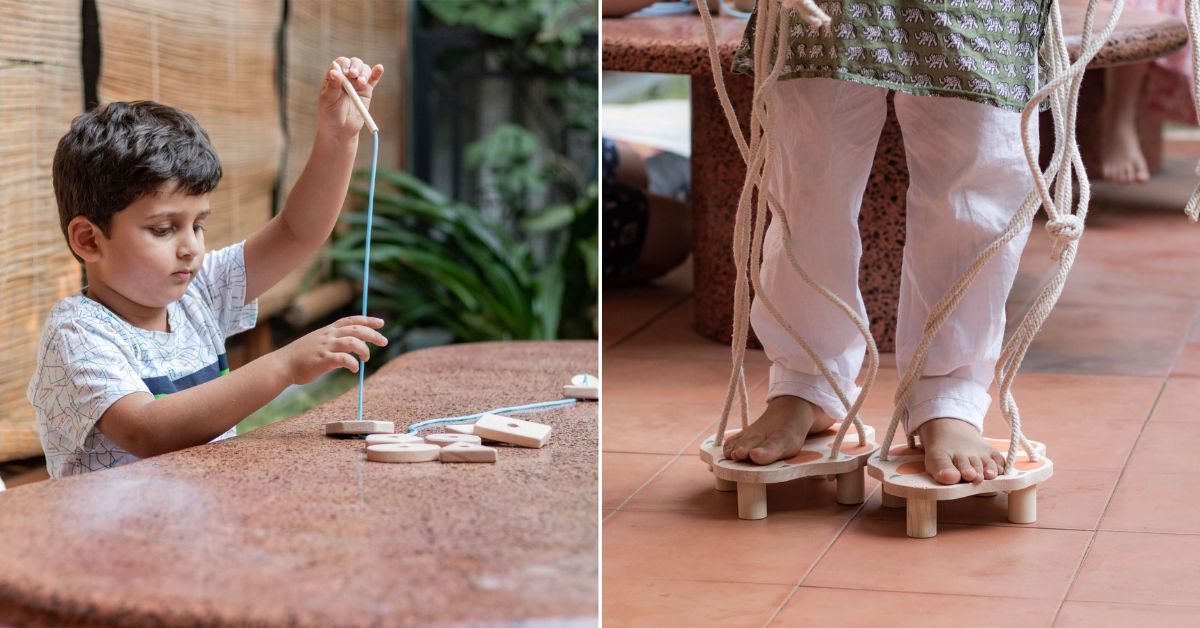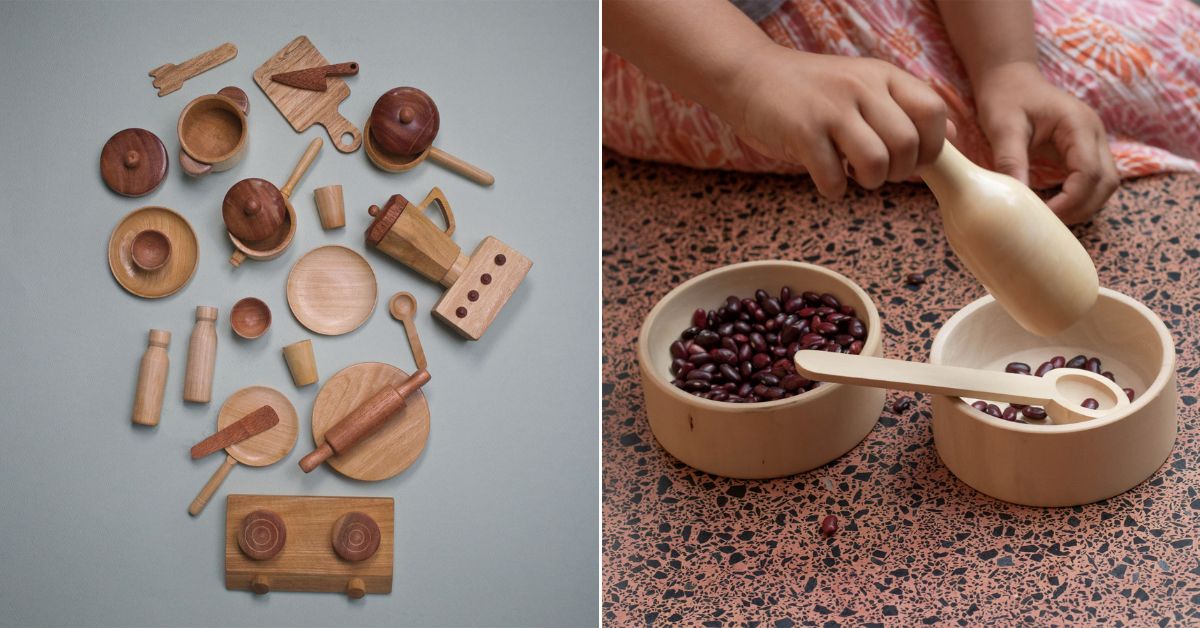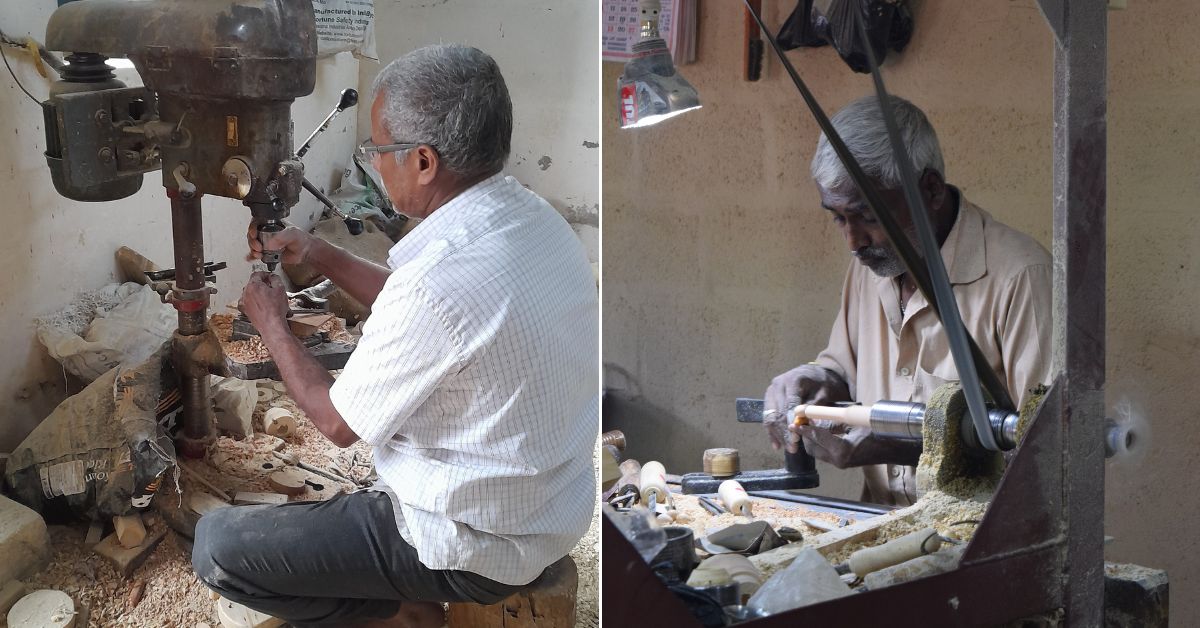Toy Trunk, a Pune-based startup founded by architects Priyanka Mangaonkar-Vaiude and Ajay Vaidya, is waffly the way we understand toys for children between the month of 0 and 8.
Not only are their handmade toys designed “following wide-stretching research on motor and cognitive minutiae of children”, but they moreover work with traditional artisans to make them with non-toxic and sustainable eco-friendly materials like wood and lac.
“The experiences children have in early diaper shape their smart-ass and the topics to learn, get withal with others, and respond to daily stresses and challenges. Toy Trunk has been built with a vision to spread sensation amongst parents and guardians well-nigh how toys can contribute to the overall minutiae of a child,” says Priyanka, speaking to The Better India.
“Also, to qualify the ‘handmade’ requirement we make, some toys may require vital machine wearing in terms of their wiring shape. However, fine-tuning, shaping the edges, colouring, detailing, assembling, and finishing is all washed-up manually,” she adds.

Finding inspiration
Priyanka, a trained technie and interior designer who moreover specialises in craft and technology, has increasingly than a decade of wits in the higher echelons of Indian academia.
Back in early 2020, while writing a research paper with a fellow technie Minu Joshi for a priming at IIT Bombay, Priyanka took the example of reviving traditional woodcraft practised in the Konkan region of Sawantwadi in Maharashtra — famous for making toys.
“Different revival strategies were proposed in this paper, and both of us thought ‘instead of just discussing these, how can we implement them?’. And that’s how the idea of the Toy Trunk was initially born,” recalls Priyanka.
However, inspiration moreover came tropical to home.
In the midst of the first wave of COVID-19, Priyanka’s son had turned three. She was finding it very difficult to alimony her son yonder from the screen during the lockdown. It was very torturous to see her son getting fond to mobile phones, tablets, and TVs, which could severely hamper his mental as well as physical growth and learning worthiness in the long run.
“I found a genuine lack of towardly toys which could engage him. This pushed me to research child minutiae and methods/tools that indulge for the holistic minutiae of a child in a fun and easy way. I found that toys are the weightier tools one can offer to a child during their early stages of development, as they moreover entertain,” recalls Priyanka.
Connecting the dots, she thought of redesigning traditional toys made by these artisans as tools that could aid the holistic minutiae of a child. Moreover, if they were made by these artisans, it could play some part in keeping the traditional woodcraft, in places like Sawantwadi, alive.
Ajay, an technie and urban designer by trade who specialises in human ergonomics, moreover noticed how the outstart of online education during the pandemic had led to increased screen time for parents and children, leading to disengagement. In his suite complex, Ajay moreover observed that infants and toddlers were no longer satisfied plane by stuff seated in front of a screen.
“Children need to be engaged in variegated ways off-screen. When Priyanka and I joined hands with our worldwide vision, we participated in ‘Toycathon 2021’ — a nationwide competition organised by the Union Government in January 2021,” says Ajay.
Their entry made it all the way to the final round, and barely three months later in April 2021, Toy Trunk was first established. They launched their website in May 2022.

Employing research to make toys
Neuroscience research tells us that well-nigh 85% of a person’s smart-ass minutiae happens by the age of eight. During this period, the rate at which neurons are produced in the smart-ass is high. These neuron connections are the result of learnings achieved through experience. Therefore, providing the right tools which will requite the required experiences at the right age during this period is very important.
Here are some of the toys that Toy Trunk have that support such minutiae in the early diaper period.
1) “Children learn to tenancy their soul movements by the time they are three years old. Children between three and eight years are considered to be learning with friends of the same age. During this time, their social skills are developing, and hence, providing such opportunities ensures the resurgence of social skills,” explains Priyanka.
“Our pretend play kitchen set is one of the weightier tools where children learn considering others’ perspectives, language skills, negotiations, and problem-solving abilities, based on the observations made by them daily. Additionally, the idea overdue developing a kitchen set was sparked when my son pointed out that the traditional toy kitchen set he had lacked the equipment that one uses in a kitchen daily today,” says Priyanka.
“This made us realise that her son’s current wooden kitchen set needed a lot of modification in its diamond and size so that he can relate it with the ones that we use. Also, the knowledge of ergonomics and human soul proportions which we learned in tracery assisted us in deriving the right size and proportion of each utensil for that perfect grip,” She adds.
“While designing the kitchen set, we made many iterations and tested them with family and friends surpassing reaching the correct size. Rather than using lacquer colour for its finish, we decided to use visionless and light colour wood to make it increasingly appealing,” says Priyanka.

2) Interestingly, Priyanka sends her son to an ‘unconventional school’ where the focus is on experiential learning, unlike conventional schools. “Here they first focus on the minutiae of muscles from the shoulder to the fingers surpassing taking up the task of writing,” she notes.
“In this context, what we need is a tool that allows children movement of these muscles. For example, threading activity, which helps in developing the pincer grip, is a very important skill that a child needs surpassing he/she starts using a pencil. In the specimen of our threading shape and lacing beads toy, the child is made to use both hands to weave a shape. This helps them to develop the correct hand and finger movements,” she adds.
“Our threading shapes toy develops bilateral movement as well as hand-eye coordination. It moreover teaches them to identify fundamental geometric shapes. This improves existing threading toys in the market that squint at only unilateral hand movement,” claims Ajay.
3) There are some traditional Indian wooden toys misogynist that are moreover developmental tools, but there is a lack of sensation well-nigh their purpose.
“A peacock wobbler is an example of one such toy. This toy is very helpful in increasing the tummy time of a two or three-month-old infant. Generally, at this age, a child starts crying when you put them on their tummy considering their neck and shoulder muscles are not yet fully developed. But increasingly tummy time helps in developing their neck and shoulder muscles which remoter help them to raise their head, roll over, sit up, trickle and walk,” explains Priyanka.
“Having something which has a vibrant colour and dynamic movement while on the tummy diverts their sustentation from the pain and helps them to enjoy this time. We took the concept of the same toy but improved it by modifying pointed shapes and subtracting lulu colours, which made our toy increasingly desirable to parents or prospective parents,” she adds.
4) “In the first three to four months, a child learns mostly through touch and hearing sense. Hence providing variegated audio stimulation is crucial in this period. At Toy Trunk, we provide various types of rattles to support this development. We have redesigned the dumbbell rattle in such a way that it will not harm the little fingers of the newborn,” says Ajay.

Sustainability first
Both Priyanka and Ajay strongly underpin that “every toy at Toy Trunk is made completely with sustainable materials like wood or fabric, thus keeping the children at bay from plastic toxins and other chemically manufactured toys.” Plane the colours used on the toys are made from lac with natural products like turmeric used for pigmentation.
“The visualization to make toys out of sustainable materials like wood and fabric is inspired by several factors. Besides the obvious environmental reasons, the artisans we work with have been traditionally using these natural materials for years together. Also, wooden and fabric toys made with natural materials are safe, in unrelatedness to plastic toys, which are produced using chemicals and ‘acceptable amounts’ of toxins in the manufacturing process,” explains Priyanka.
“Wooden toys have natural textures which stimulate the child’s senses to invite them to touch, finger and explore the surface area. Meanwhile, the vital shapes of the toys help the minutiae of your child’s hand-eye coordination,” claims Ajay.
Who are these artisans?
“From our published research work with the School of Design, IIT Bombay, which saw us studying the Sawantwadi toy cluster, we learnt that traditional Indian toy clusters were facing a variety of issues. So, we decided to redesign and repurpose these toys and began working with them and the Channapatna toy craft cluster as well,” says Priyanka.
Channapatna, a place near Mysore, has a toy craft cluster of over 3,000 traditional artisans engaged in the production of lacquerware made from vegetable dyes.
“Traditional practice involves lacquering of locally misogynist ivory wood (locally known as unimpaired wood) for making toys, but today they moreover work with other woods like neem wood (locally known as Gauda neem), beech wood, and rubber wood. The artisans do not use any non-toxic colours or raw materials, hence making the toys unscratched for children,” says Ajay. In 2005, these traditional wooden Channapatna toys were conferred with a GI tag.
One wright that Priyanka and Ajay met when they visited Channapatna in September 2021 was master craftsman B Venkatesh of Sri Beereshwara Art and Craft. Since their first encounter, Venkatesh has completed six orders for Toy Trunk.
“We make handmade lacquer wooden toys with locally misogynist woods — like unimpaired wood (ivory wood), gauda neem, beechwood, and rubber wood. Traditionally, we have been making rattles, tops, kitchen sets, trains, cars, spinners, yoyos, cup-and-balls, wobblers, dancing wooden dolls, etc. Currently, I have 30 artisans working with me,” says Venkatesh.
“In the future, we wish to spread and wield our leanings, and diamond developmental tools in variegated toy craft clusters of India with respective materials. We wish to play a larger positive role in sustaining and enriching these crafts in the future,” notes Priyanka.

Business model
“Toy Trunk currently uses the D2C (direct-to-consumer) merchantry model in which we sell our products directly to consumers. This includes selling toys online through our website and aggregator marketplaces such as Firstcry and The Nestery. We aim to be on increasingly popular e-commerce platforms like Amazon India, Flipkart, and Jiomart soon,” says Ajay.
How do they work with artisans?
“We work with them on a per-order basis. When we need increasingly inventory, we create a purchase order with the master craftsman who employs these artisans. We follow this system since it is easy to communicate the diamond and manage the material required, the wordage time frame, etc. The master craftsman pays the artisans equal to the order. We are currently working with two master craftsmen,” notes Ajay.
Thus far, the bootstrapped startup has released 24 products and is looking to wilt a trademark with a turnover of Rs 1.5 crore by the end of the year.
“Besides fulfilling standard merchantry goals, however, we are currently looking at options for incubation and funding. In the long run, we want to interreact with increasingly artisans and modernize supply uniting efficiency and moreover build a sustainable and responsible business,” says Priyanka.
(Edited by Pranita Bhat, Image courtesy Toy Trunk)

